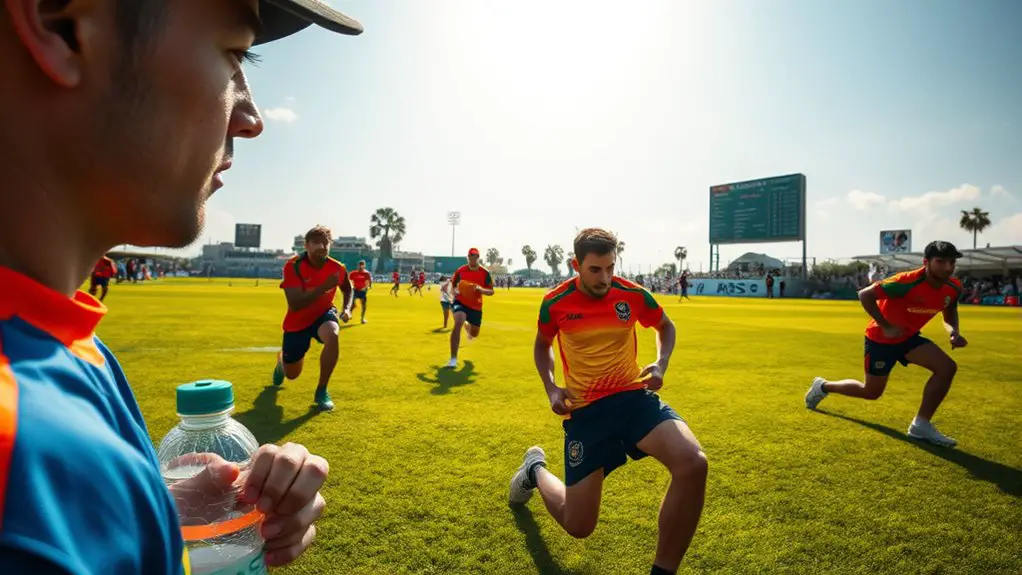To optimize your breathing for sprinting efficiency, focus on deep, diaphragmatic breaths to maximize oxygen intake. Try syncing your breathing with your strides: inhale for two steps and exhale for the next two. This rhythm helps maintain focus and reduces fatigue. Incorporate breathing drills into your training, practicing quick and controlled breaths. Remember, adjusting your breath during tougher segments can improve your performance, and there's so much more to explore on this crucial aspect.
Understanding the Importance of Breathing in Sprinting
When you sprint, the way you breathe can make a significant difference in your performance. Your breath isn't just a background process; it fuels your body and keeps your energy levels high. Without proper breathing, you might feel fatigued or struggle to maintain your pace. Think of each breath as a lifeline, providing the oxygen your muscles crave for explosive power.
Understanding the importance of breathing means you'll tap into your potential more freely. When you synchronize your breath with your stride, you'll feel more in control and confident. The rhythm of your breath can even help clear your mind, allowing you to embrace the thrill of sprinting without distractions. So, don't overlook this essential aspect of your running routine. Mastering your breath will not only enhance your performance but also deepen your connection to the exhilarating freedom that comes with sprinting.
Breathing Techniques for Optimal Performance
Mastering breathing techniques can elevate your sprinting game considerably. By focusing on your breath, you'll enhance your performance and maintain your energy throughout your races. Here are a few techniques to contemplate:
| Technique | Description |
|---|---|
| Quick Breathing | Inhale deeply through your nose, then exhale forcefully through your mouth. This boosts oxygen intake and expels CO2 efficiently. |
| Rhythm Breathing | Sync your breathing with your strides, inhaling for a set number of steps and exhaling for the same. This creates a natural flow. |
| Nose to Mouth | Start inhaling through your nose to warm the air, then exhale through your mouth. This balances oxygen delivery and keeps you relaxed. |
Implementing these techniques not only helps you stay focused but also gives you the freedom to push your limits. With practice, you'll find the rhythm that best suits your sprinting style.
The Role of Diaphragmatic Breathing
Though many sprinters focus on pace and technique, the importance of diaphragmatic breathing can't be overlooked. This type of breathing engages your diaphragm, allowing for deeper air intake and greater oxygen delivery to your muscles. When you breathe with your diaphragm, you're not just filling your lungs; you're maximizing your lung capacity, which means more energy for those powerful sprints.
By using your diaphragm, you can reduce the stress on your upper body, keeping your shoulders relaxed and your stride fluid. This efficient breathing pattern also helps maintain focus and reduces anxiety, which can be a game changer when you're racing. Moreover, quality sleep plays a crucial role in enhancing your overall recovery and performance, allowing you to train harder and sprint faster.
Practicing diaphragmatic breathing outside of your sprint sessions can enhance your overall performance. As you learn to breathe deeply, you'll feel lighter and more liberated, allowing you to push your limits without feeling stifled. Embrace this technique, and watch how it transforms your sprinting experience.
Timing Your Breath With Your Strides
To maximize your sprinting efficiency, it's essential to coordinate your breath with your strides. Finding the right rhythm for inhaling and exhaling can help sustain your energy and improve your performance. Let's explore the best breathing patterns that can elevate your sprinting game.
Breath Coordination With Strides
As you sprint, coordinating your breath with your strides can considerably enhance your performance. This synchronization allows your body to work more efficiently, maximizing oxygen intake while minimizing fatigue. You should aim to establish a rhythm that feels natural—breathe in during a few strides and exhale as you push off the ground. It's all about finding a flow that complements your speed and stride length. When you align your breathing with your movement, you'll feel lighter and more in tune with your body. Experiment with different patterns to see what suits you best; maybe you'll prefer a quick inhale for every two strides. Ultimately, it's about embracing that freedom of movement and breath, letting them propel you forward.
Inhale and Exhale Rhythm
Finding the right inhale and exhale rhythm can make a significant difference in your sprinting efficiency. You'll want to sync your breath with your strides to maximize oxygen intake and maintain energy. For instance, try inhaling for two to three steps and exhaling for the same amount. This keeps your breathing steady and your body relaxed.
As you sprint, listen to your body; adjust your rhythm if you feel out of breath. You don't want your breathing to become a burden. Instead, let it flow naturally, enhancing your movement rather than restricting it. Keep practicing this timing, and soon you'll find that perfect balance, allowing you to sprint with more freedom and less fatigue.
Optimal Breathing Patterns
While sprinting, timing your breath with your strides is essential for maximizing efficiency and performance. To achieve this, you'll want to synchronize your inhalations and exhalations with your footfalls. For instance, try inhaling every two strides and exhaling in the next two. This pattern keeps your oxygen flow consistent, fueling those powerful bursts of speed. As you get comfortable, you can adjust the rhythm to suit your pace and style. Remember, it's all about finding what feels natural for you. Stay relaxed; a tense body can hinder your sprint. By mastering your breath, you'll not only enhance your endurance but also embrace the joy of running freely, feeling every stride with purpose and ease.
Practicing Breathing Drills for Sprinting
Practicing breathing drills can greatly enhance your sprinting efficiency, especially when you focus on integrating proper techniques into your training routine. Start with diaphragmatic breathing; it allows for deeper breaths, filling your lungs and delivering more oxygen to your muscles. While jogging, inhale deeply through your nose for a count of three, then exhale through your mouth for a count of four. This'll help you regulate your breath during sprints.
Incorporate rhythmic breathing; sync your breaths with your stride to maintain a steady flow of oxygen. For instance, try inhaling for two steps and exhaling for two. As you get comfortable, increase your pace and intensity.
Finally, practice controlled breathing during short sprints. Focus on maintaining your rhythm and staying relaxed. With consistent practice, you'll find that optimizing your breath not only boosts your performance but also gives you that exhilarating sense of freedom while sprinting.
Incorporating Breathing Exercises Into Your Training
Incorporate breathing exercises into your training to enhance your sprinting performance and overall endurance. Start with diaphragmatic breathing, where you focus on expanding your belly instead of your chest. This method increases oxygen intake and helps you stay relaxed under pressure.
Try incorporating breath control drills during your warm-ups. As you jog, practice inhaling for four counts, holding for two, then exhaling for six. This technique builds lung capacity and enhances your ability to manage breath during sprints.
Don't forget to integrate breathing exercises into your cooldown routine too. A simple way to wind down is through deep, slow breaths, which aids recovery and reduces muscle tension. Additionally, practicing techniques like diaphragmatic breathing can further improve your performance during high-intensity efforts.
Monitoring and Adjusting Your Breathing During Races
As you prepare for races, it's important to monitor and adjust your breathing to match the intensity of your efforts. You'll want to stay in tune with your body's rhythm, finding a balance that supports your sprinting without constricting your freedom. During the race, pay attention to how your breath changes with your pace. If you notice short, shallow breaths, it's time to consciously deepen your inhalations and lengthen your exhalations. This helps deliver more oxygen to your muscles and keeps you feeling light and agile.
Practice rhythmic breathing, syncing it with your strides, which can enhance your focus and reduce fatigue. If you hit a tough patch, don't hesitate to adjust your breathing pattern to regain control. Embrace the dynamic nature of your breath as a tool that empowers you to push through, allowing you to sprint with both efficiency and freedom.
Frequently Asked Questions
How Can Anxiety Affect My Breathing During Sprints?
Anxiety can tighten your chest and disrupt your natural rhythm, causing shallow breaths. When sprinting, it's crucial to stay relaxed; otherwise, you'll struggle to get enough oxygen, hindering your performance and overall enjoyment.
What Are Common Breathing Mistakes Sprinters Make?
Ever felt like you're gasping for air? Many sprinters make common mistakes, like shallow breathing or holding their breath. You should focus on deep, rhythmic breaths to release your full sprinting potential and run free.
Does Altitude Impact My Breathing Efficiency in Sprinting?
Yes, altitude affects your breathing efficiency during sprints. Thinner air means less oxygen, making it tougher to maintain performance. You might feel more fatigued, so adjusting your training at higher elevations is essential for ideal results.
Can Yoga Improve My Sprinting Breath Control?
Absolutely, yoga can enhance your breath control. It teaches you to focus on deep, rhythmic breathing, which can improve lung capacity and efficiency. You'll feel more relaxed and powerful during those intense sprints, freeing your performance.
Should I Breathe Through My Nose or Mouth While Sprinting?
You'd think breathing's simple, right? But while sprinting, it's often better to breathe through your mouth for quick oxygen intake. Your body craves freedom, so let it flow without restrictions—just don't forget to exhale!




